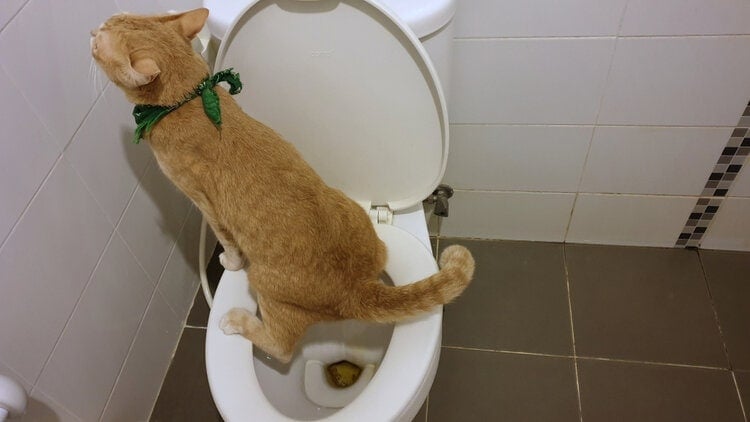Reasons Flushing Cat Poop Down Your Toilet Isn't a Good Idea - Tips for Safer Handling
Reasons Flushing Cat Poop Down Your Toilet Isn't a Good Idea - Tips for Safer Handling
Blog Article
Have you been searching for guidance concerning Don’t flush cat feces down the toilet?
Intro
As cat owners, it's important to be mindful of just how we dispose of our feline pals' waste. While it may appear hassle-free to purge cat poop down the bathroom, this method can have damaging repercussions for both the atmosphere and human wellness.
Ecological Impact
Purging pet cat poop introduces hazardous pathogens and parasites into the water system, presenting a substantial danger to water environments. These impurities can adversely influence aquatic life and concession water top quality.
Wellness Risks
In addition to environmental issues, flushing pet cat waste can additionally present health and wellness dangers to people. Cat feces may contain Toxoplasma gondii, a parasite that can create toxoplasmosis-- a possibly serious disease, especially for pregnant females and individuals with weakened immune systems.
Alternatives to Flushing
Fortunately, there are more secure and extra accountable methods to dispose of pet cat poop. Take into consideration the following alternatives:
1. Scoop and Dispose in Trash
One of the most typical technique of getting rid of cat poop is to scoop it right into an eco-friendly bag and throw it in the garbage. Make sure to use a dedicated trash scoop and take care of the waste without delay.
2. Use Biodegradable Litter
Opt for naturally degradable cat clutter made from materials such as corn or wheat. These litters are environmentally friendly and can be safely disposed of in the trash.
3. Bury in the Yard
If you have a lawn, take into consideration burying pet cat waste in a designated location far from veggie gardens and water resources. Be sure to dig deep adequate to prevent contamination of groundwater.
4. Mount a Pet Waste Disposal System
Invest in a pet dog garbage disposal system specifically developed for pet cat waste. These systems use enzymes to break down the waste, minimizing odor and ecological effect.
Conclusion
Liable animal ownership expands beyond giving food and sanctuary-- it also includes correct waste administration. By avoiding flushing feline poop down the commode and choosing alternate disposal approaches, we can reduce our ecological impact and protect human health and wellness.
Why Can’t I Flush Cat Poop?
It Spreads a Parasite
Cats are frequently infected with a parasite called toxoplasma gondii. The parasite causes an infection called toxoplasmosis. It is usually harmless to cats. The parasite only uses cat poop as a host for its eggs. Otherwise, the cat’s immune system usually keeps the infection at low enough levels to maintain its own health. But it does not stop the develop of eggs. These eggs are tiny and surprisingly tough. They may survive for a year before they begin to grow. But that’s the problem.
Our wastewater system is not designed to deal with toxoplasmosis eggs. Instead, most eggs will flush from your toilet into sewers and wastewater management plants. After the sewage is treated for many other harmful things in it, it is typically released into local rivers, lakes, or oceans. Here, the toxoplasmosis eggs can find new hosts, including starfish, crabs, otters, and many other wildlife. For many, this is a significant risk to their health. Toxoplasmosis can also end up infecting water sources that are important for agriculture, which means our deer, pigs, and sheep can get infected too.
Is There Risk to Humans?
There can be a risk to human life from flushing cat poop down the toilet. If you do so, the parasites from your cat’s poop can end up in shellfish, game animals, or livestock. If this meat is then served raw or undercooked, the people who eat it can get sick.
In fact, according to the CDC, 40 million people in the United States are infected with toxoplasma gondii. They get it from exposure to infected seafood, or from some kind of cat poop contamination, like drinking from a stream that is contaminated or touching anything that has come into contact with cat poop. That includes just cleaning a cat litter box.
Most people who get infected with these parasites will not develop any symptoms. However, for pregnant women or for those with compromised immune systems, the parasite can cause severe health problems.
How to Handle Cat Poop
The best way to handle cat poop is actually to clean the box more often. The eggs that the parasite sheds will not become active until one to five days after the cat poops. That means that if you clean daily, you’re much less likely to come into direct contact with infectious eggs.
That said, always dispose of cat poop in the garbage and not down the toilet. Wash your hands before and after you clean the litter box, and bring the bag of poop right outside to your garbage bins.
https://trenchlesssolutionsusa.com/why-cant-i-flush-cat-poop/

Do you appreciate more info about How to Dispose of Cat Poop and Litter Without Plastic Bags? Write feedback further down. We'd be pleased to hear your opinion about this content. Hoping that you visit us again before long. Enjoyed our post? Please share it. Let others discover it. Bless you for your time. Kindly come visit our site back soon.
Visit Page Report this page